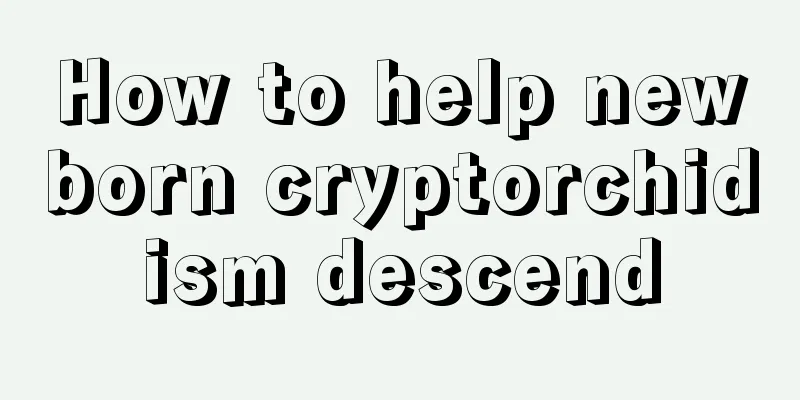How to help newborn cryptorchidism descend

|
The testicles are a very important part of the male reproductive organ. For men, the importance of testicles is like that of women's uterus. It plays a very important role in the continuation of people's offspring. However, some newborns may be born with testicular problems, such as cryptorchidism. Compared with other normal testicular development, cryptorchidism is located higher. So when a newborn baby is found to have cryptorchidism, what measures should be taken to help it descend? 1. How to help newborn cryptorchidism descend Cryptorchidism can be treated by surgically placing the testicles into the scrotum and fixing them there. The best time for surgery is between 5 and 6 years old. If it is performed too late, the developmental disorder of the testicles cannot be restored and the possibility of tumor development will be greater. 2. What is cryptorchidism? 1. Cryptorchidism refers to a deformity in which the bilateral or unilateral testicles do not descend into the scrotum 2 months after the baby is born. There are two types of cryptorchidism: true cryptorchidism and pseudocryptorchidism. Pseudocryptorchidism means that the testicles cannot be reached in the scrotal lining, but can be felt above the scrotum or in the groin; true cryptorchidism means that not only can the testicles not be reached in the scrotal lining, but the testicles cannot be felt even in the upper scrotum or in the groin. Their position is too high, often located in the abdominal cavity. Whether it is true or false cryptorchidism, or bilateral or unilateral cryptorchidism, it is collectively called cryptorchidism. 2. After the testicles leave the scrotum, they are in a relatively high temperature environment. The increase in testicular temperature primarily destroys the testicular spermatogenesis function. If it is bilateral cryptorchidism, the boy may develop azoospermia in adulthood, resulting in male infertility; even if it is unilateral cryptorchidism, the destruction of the cryptorchidism will produce multiple anti-sperm antibodies, affecting fertility. 3. Surgery for cryptorchidism 1. Cryptorchidism is usually treated with hormone therapy first, usually human chorionic gonadotropin (hCG), which has an effective rate of 30-40%. The effectiveness of hormone therapy is closely related to the location of the cryptorchidism; the lower the location, the better the effect. When hormone therapy is ineffective, surgical treatment should be resorted to. 2. Cryptorchidism surgery generally refers to laparoscopic treatment. Laparoscopic therapy is the application of micro-tube endoscope technology in the exploration and treatment of occult testis. The biggest advantage of laparoscopy is that it does not damage the anatomical structure of the inguinal area or the levator testis muscle, and can accurately locate the testicles or confirm agenesis, avoiding blind exploration. It can also release the spermatic cord at the highest position, allowing it to drop tensionlessly to the bottom of the scrotum and be fixed. It has small damage, fast recovery, short hospitalization time, and a wound of 0.3-0.4cm. In recent years, it has been widely used in the diagnosis and treatment of cryptorchidism. |
<<: Do newborns need to take cod liver oil?
>>: How long does it take for a newborn to shed tears?
Recommend
What are the symptoms of zinc deficiency in infants and young children?
Zinc is an essential trace element for the human ...
How to prevent newborns from choking on milk
For newborns, the best nutrition comes from mothe...
How do you know if your child is zinc deficient?
Zinc is an essential nutrient for the human body....
Will teething cause fever?
I believe that many mothers have found that when ...
What to do if your child has dry skin? These methods are simple but effective!
Under normal circumstances, the baby's skin s...
What causes night terrors?
From birth to adulthood, sleep is very important ...
Treatment of mental retardation in children
If a child has intellectual disability during his...
What are the effects of high lead levels on children?
There are many trace elements in the human body, ...
What to do if your baby coughs while feeding
After the baby is born, many mothers prefer breas...
What to do if a child falls on his head? Parents should be cautious
We all know that the older children get, the more...
What should a four-month-old baby with anemia eat?
As for anemia, many babies nowadays have this con...
What are the disadvantages of baby swimming?
Most babies like water. In order to let their bab...
Side effects of growth hormone injections in children
I believe that most of the reasons why people kno...
Newborn baby has red spots in the eyes
When a pregnant woman is giving birth, she can ch...
What to do if a nine-year-old child coughs
Many children have weak resistance and often suff...









